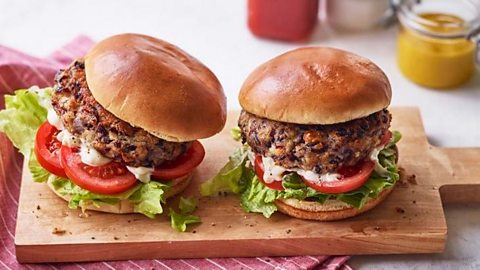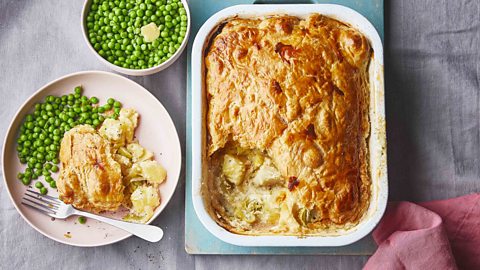The secrets behind our favourite pub foods
Yes, there’s a time and a place for elegant small plates and dishes with fifteen different spices. But when nothing but the best bar snacks, roasts and pies will do, complemented by a solid range of ales, the pub is the place.
We asked top UK chefs to tell us their favourite pub dishes, and the secrets to recreating those classic dishes at home. From baked potato mash using “an obscene amount of butter” to changing up your cheese in a ploughman's, these simple tricks (including some from Michelin-starred chefs) will bring the pub a little closer to home.
Starters and bar snacks

Prawn cocktail
The ‘80s classic has had something of a renaissance in recent years and Luke French, JÖRO, Sheffield is a big fan. “For the prawn cocktail starter, make a good Marie Rose sauce! Use good quality mayonnaise, season to taste with good quality tomato ketchup, a pinch of salt, a grind of black pepper and most importantly a good splash of hot sauce. If using frozen prawns make sure you defrost them on a bit of kitchen paper to absorb all the water that comes out before you mix into your sauce! This is absolutely mega with Little Gem lettuce and a wedge of lemon, in a glass, obviously."
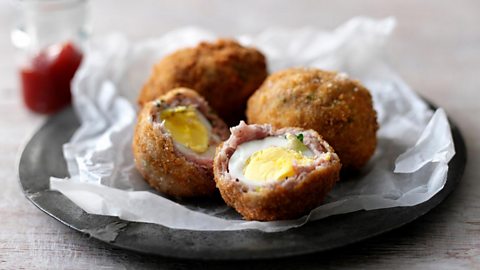
Scotch egg
A favourite of Jun Tanaka from The Ninth, London, he explains the humble scotch egg can be a bit tricky to make, but following a few simple rules will mean you can knock them out at home easily. The secret is getting the egg cooked, but cold, especially if you like the yolk to stay a bit runny in the middle. “The eggs should be boiled for five minutes and thirty seconds and refreshed in cold water. For each egg, the perfect quantity of sausage meat is 70g. Wrap this around the egg using cling film. Allow this to set in the fridge for two hours."
Once you're ready to fry, remove the cling film and bread the egg in two layers of panko breadcrumbs, for maximum crispness. “This is important to keep the Scotch egg from splitting while cooking. Deep-fry for five minutes at 190C then rest for a further five minutes in a warm place. Cut in half and the egg will be perfectly runny."

Fried whitebait
There’s something rather special about whitebait. Maybe we associate it with the glory that is the pub garden, ideally along a river, in the few rare days of an English summer. Whitebait are nearly always frozen on the fishing boat, so you can fry them from frozen. They can be breaded, battered or just dusted with flour prior to frying.
Whichever coating you choose, the goal is crispness, says James Close from Raby Hunt, Darlington, whose secret is to work in small batches. “Always use sunflower oil at 180C and fry for two minutes in small batches so they don't stick together. After frying, lay on a wire rack to drain excess oil off to keep them very crispy. I personally enjoy them with a dusting of cayenne pepper and a touch of rock salt. Serve it with loads of lemon and aioli to jazz it up.”
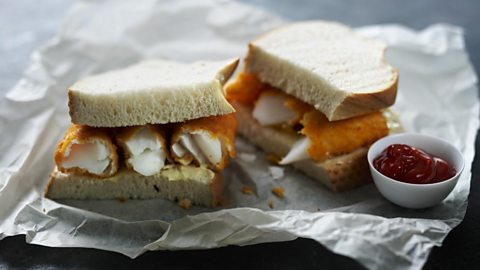
Fish finger sandwich with chunky chips
The go-to pub sandwich for many of us, Aktar Islam, Opheem, Birmingham loves making his own fish finger sandwich at home. Yes, shop-bought fish fingers – or scampi – will do, but if you want to take your sandwich up a notch make your own. “Cut your fish fillet into two thick wedges, coat in salt and sugar in equal proportions, leave for around five minutes then wash off and pat the fish dry. Then deep-fry your fillets in beer batter for the ultimate crunch – delicious.
“A good quality mayonnaise is essential, especially when it comes to making tartare sauce, add in chives, pickled gherkins, and shallots. I like to crush through a boiled egg white for texture, and finish with a little bit of fresh lemon juice and small amount of French mustard – Voilá!”
As for the chips? These are the best chips you have ever tasted.
Related stories
Main courses
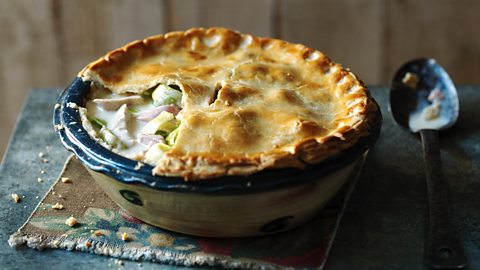
Pie and mash
It seems the humble pie is a firm favourite with chefs, though the type of pie differs from expert to expert. Mike Naidoo, Catch, Weymouth opts for chicken, ham and leek pie, served with olive oil mash and a pint of local Dorset cider. His surprising tip? “I would tend to buy a good ready-made pastry when making this at home; it’s much more convenient and the quality is reliable.”
Meanwhile, Tom Shepherd, Upstairs, Lichfield prefers the hearty steak and ale pie. “Always serve it with mash. You have to use a dry, floury potato and bake them whole. Once cooked, scoop out the inner and beat in butter until smooth and silky, adding a little cream if it’s too thick.”
Jake Leach, The Harwood Arms, London agrees with Shepherd about the pie choice and adds: “Source some great meat as it forms the foundation of the dish, including the gravy!”
For a veggie option, Lisa Goodwin-Allen, The Game Bird at The Stafford, London and Northcote, suggests Lancashire’s favourite: cheese and onion pie. But don't just rest on one cheese. “Buy different cheeses and blend them together to get a fabulous flavour.”
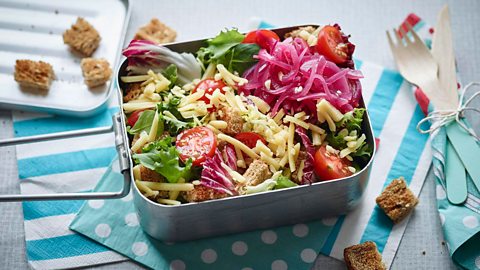
Ploughman’s lunch
For the person who wants a bit of everything, there’s nothing quite like a ploughman’s lunch says Simon Hulstone, Elephant, Torquay. His advice when recreating it at home? “Really personalise it, using up your favourite cold cuts from the fridge or buy some of the fantastic local charcuterie that’s widely available now. I’d always serve with a scotch egg. A ploughman’s has to have some good cheeses, I’d recommend a variety of hard, soft and maybe a blue cheese. Serve with the best fresh baked artisan bread and glass of your favourite ale."
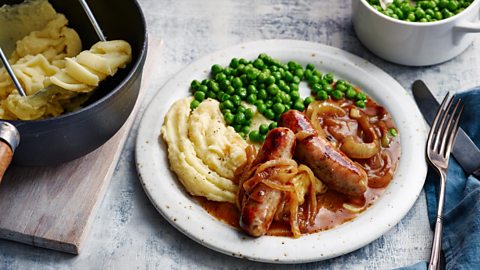
Sausage and mash
When a dish is as simple as this, you've got to do it just right. Holly Taylor, Kindling Restaurant, Brighton is a big fan of sausage and mash and also advocates the radical baked-potato mash. “Make a baked potato mash with an obscene amount of butter. Baking the potatoes instead of boiling them creates a mash that has a deep potato flavour and beautiful texture. We also bake the sausages so they go extra crispy instead of frying them.”
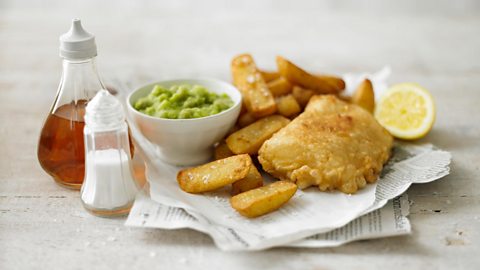
Fish, chips and mushy peas
Like pies, fish and chips is a big hit with the country’s best chefs. Tom Brown, Cornerstone, London, advises: “Opt for hake rather than cod as it’s more sustainable. Use gluten-free self-raising flour for the batter, as it gives the fish a really nice crispy texture (a bit like tempura).”
Meanwhile, Benjamin Palmer, The Sardine Factory, Cornwall, says: “Always double, if not triple fry, your chips!” and when it comes to the batter? “Use a local carbonated hoppy ale for extra light crispiness and depth of flavour.”
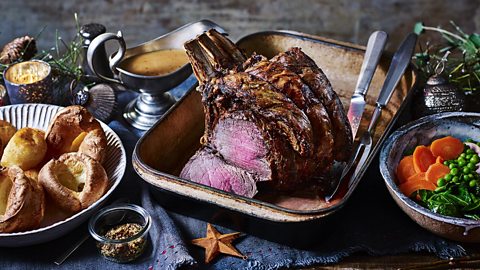
A traditional roast
There’s nothing quite like a Sunday roast and our experts agree! Tom Kerridge, of multiple pubs/restaurants, including The Coach, Marlow, loves roast beef and Yorkshire pudding. His top tip? “Get yourself a brilliant bit of beef, cook it at 60C until the core temperature of it reaches 58C. This can take up to four hours dependant on the cut and size. Remove from the oven, sear in a pan for a lovely crust. That way the beef is guaranteed medium rare in the middle. Also, when making Yorkshire puddings, do not open the oven door too early! Just leave them to keep cooking!”
Tom's a fan of the long, gentle approach for his slow roast chicken as well. Cooking slowly at a low temperature keeps the meat juicy, with just a quick blast to crisp it up at the end. Tom's slow-roast lamb shoulder was one of the highlights of his Proper Pub Food series.
Puddings
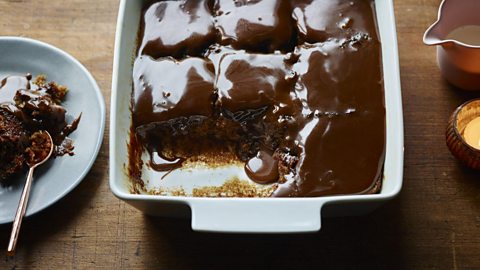
Sticky toffee pudding
Literally every chef wanted a sticky toffee pudding at the end of their pub dinner. Omar Meziane, former England men’s football team chef says sticky toffee pudding is his must-have dessert. “Add either walnuts or pecans to the mixture to give it some texture, and always pour some of the butterscotch sauce into the bottom of the baking tin and then add the cake mix and bake,” he says.
Luke French adds: “Take the water that you would use to cook the dates in, and replace this with hot Earl Grey tea, and cover the dates overnight, before chopping into chunks and folding through your pudding mix. Also, a spoon of miso paste in your sticky toffee pudding sauce is just the ticket to make it that little extra special. And don’t forget the salt – make sure to season your pudding and the sauce, too!”
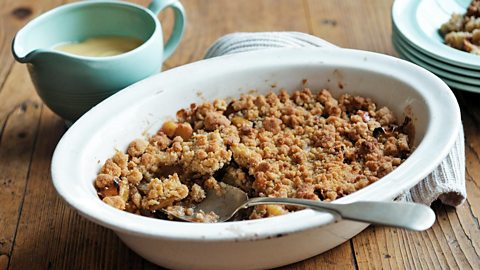
Fruit crumble
In the interest of balance, alternative roast dinner dessert are available. We thought we'd make our own case for the crumble. Whether it’s apple, rhubarb or something different, like Nigella's plum and amaretti crumble, it’s hard to beat the comfort of a crumble while you’re sitting next to a pub fire. Our top tip? Use the crumble layer to add extra flavours and textures. It can be as simple as adding in oats and demerara sugar or flaked almonds. Or take Mary Berry's tip and make the crumble topping separately to sprinkle over any cooked fruit. Perfect if you're too full and need to save your pudding for breakfast.
Now you decide!
What's your dream pub meal? Vote below and see how popular your pub-grub opinion is!
